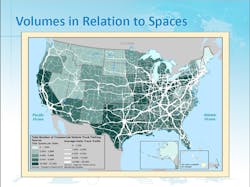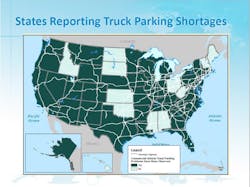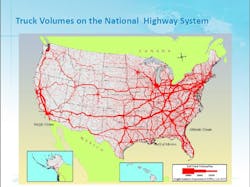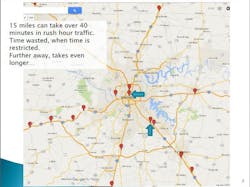Truck parking: The everywhere problem everything's causing
Efforts continue to try to figure out why commercial truck drivers frequently can't find parking when and where they need it, and researchers are pointing to everything from the economy to federal Hours of Service (HOS) regulations to prostitution as contributors to the problem.
Those were some points that came up in a webinar Wednesday, Oct. 21 discussing more findings from the Federal Highway Administration's (FHWA) study of truck parking undertaken thanks to Jason's Law. Rolled into the current highway funding legislation, Jason's Law is named for Jason Rivenburg, a truck driver shot and killed in 2009 after he was forced to park in an unsafe location.
One thing listeners heard in the webinar is that the truck parking issue is confoundingly complex, with many factors that come into play. The good news, however, is that ideas are percolating in the public and private sectors to help fix the problem, and there have been some successes in that regard.
Helping bring together and advance those ideas, FHWA plans a kickoff of its new National Coalition on Truck Parking — which includes federal agencies, state highway and transportation departments, and private trucking groups — at a meeting in Washington, DC on Tuesday, Nov. 10. FHWA's Nicole Katsikides, manager of the agency's Freight Performance Program, said the plan from there is to have a series of regional meetings and continue the discussion.
Katsikides gave an update on Jason's Law study findings and how much has been discerned so far about truck parking. She said that about 72% of states reported having problems with truck parking, mainly in metro regions along trucking corridors during the week and at night.
But when FHWA spoke with truck drivers, logistics personnel and others such as truck stop owners, the figure was much closer to 100% claiming there are problems finding parking just about anytime, and in more rural areas sometimes as well. So the problem of truck parking availability begins to look more universal.
Still, the data needed to hone in on the problem and where it's most pronounced isn't really there yet, Katsikides noted. That becomes an issue because if you can't measure and determine the finer details of the problem, you won't be able to tell if anything you're doing to fix it is working.
"One of the challenges with Jason's Law — and we get asked a lot of questions like 'Well, why didn't you get this information' or 'why didn't you get that information' — is we really found a varying degree of levels of data that states had," she said. States did have good info on truck parking facilities, whether the facilities are public or private, and how many spaces are available.
Katsikides presented a more detailed supply-and-demand look at truck volumes versus availability of parking, but she noted that more information is needed. The agency has developed measures for eight categories to gather a better picture: parking demand, parking supply, economic valuation, safety, driver demographics, location, environment and development.
FHWA also came up with additional tiers of data collection in these categories, but the agency will need help from the public and private sectors to come up with that information, according to Katsikides. "We may not have data, we may not have approaches to collect them, but [the additional tiers of measures] definitely get at those broader eight categories that we identified," she told listeners.
Contributors to the problem(s)
Getting past current data and metrics limitations, the webinar presenters talked about what's causing the truck parking problem in the first place. Though they're designed to keep drivers and trucks on the roadways safer, HOS regulations for commercial drivers also help create and complicate the parking problem, according to Scott Grenerth, director of regulatory affairs at the Owner Operator Independent Drivers Association (OOIDA).
OOIDA is part of FHWA's parking coalition, and Grenerth was an over-the-road truck driver for 13 years until recently. Boiling it down, since HOS requirements are very strict regarding the number of hours a driver can drive and breaks that he or she must take in order to legally keep working, drivers must maximize their productive time down to the minute in order to be successful at their jobs.
Why is that important? Because in today's highway/infrastructure reality of often-snarled traffic, drivers have to park very close to their next target destination or else risk losing too many precious minutes of available drive time.
"Let me use an example from when I drove, which was only a year and a half ago," Grenerth said. He described having to make a delivery in Nashville, TN, where truck parking in or near downtown was often very limited. Safe parking was available, he said, maybe just 15 miles away.
"But that 15-mile trip can make a real difference," Grenerth contended, adding that he'd just looked it up and covering those 15 miles could take about 45 minutes in traffic.
"The difference when you can park close to your shipper or receiver can be dramatic. When you go back to your Hours of Service where you're restricted on the amount of hours you have, it's not something where the drivers can just say, 'You know, I'm going to park wherever parking is available,'" Grenerth said. "That is not a recipe for economic success.
"You need to be closer to where you're delivering or picking up, or else you've got that clock running against you with the Hours of Service that the Federal Motor Carriers Safety Administration in past years has only made more and more restrictive," he continued.
"That is a huge issue for drivers," Grenerth contended. "When we look at parking . . . we really need to consider that drivers, more than ever, need to be where they are going."
Add problem shipper and receiver practices to the mix. They may tell a driver to expect to pick up or drop off a load at a certain time but fail to be ready, holding up the driver for hours. "And even if they detain a driver at a shipping or receiving facility, that doesn't mean they're going to have any sympathy for that driver when they're done causing the delay," Grenerth said.
The shipper or receiver may deny the truck driver parking there, and the driver — thus delayed — may well have problems finding any available parking or end up leaving during rush hour after having planned, for example, a 1:00 a.m. pickup.
From maybe 5:00 or 6:00 p.m. until when "early birds" are leaving truck stop parking to beat morning traffic around 3:00 or 4:00 a.m., Grenerth said, in terms of finding close by parking in Nashville for that delayed driver, "good luck."
Christopher McKenney, an engineering research technician with the Arkansas State Highway and Transportation Department, discussed some other factors that have contributed to truck parking scarcity over the years.
"As the U.S. was going through its recession, we were counting fewer trucks and more spaces," he explained. "Then in 2010 when the economy was turning around, the number of trucks started to increase and spaces began to decrease. And by 2012, you see the inverse, where we have more trucks than we do spaces, so we have overpopulation."
McKenney and Grenerth noted that many truck stops went out of business during that recession cycle. And McKenney also highlighted the situation commonly seen today where truckers choose to park on highway shoulders or to the side of on- and off-ramps, which they may be forced to do by a lack of parking anywhere else.
But even where there is parking available, sometimes truck drivers opt for those locations. Prostitutes may come bother them at certain truck stops, McKenney gave as one example, "and drivers tend to park where they can achieve their full night's rest" rather than having someone come knock on their door.
Road or access ramp shoulders usually aren't built to handle heavy truck weight, he added, which means truckers parked there can quickly damage pavement and require costly repairs.
Many more factors fold into this equation, the presenters said, and make it a difficult problem for any one solution to fix. For example, communities often lack understanding or have a negative view of trucking and freight movement, and the reaction is something like "not in my back yard" when it comes to adding truck parking facilities near them.
Ideas that could help
Still, there has been some success in making progress with the truck parking conundrum. Grenerth said part of the key is to take new approaches to it.
"We need to do something different," he contended. "The same thing gets tried over and over again. We'd all love a full-service truck stop available everywhere there's a truck stop, but parking — just period, parking — has got to be the priority, and finding places where that can happen."
For instance, industrial parks where businesses have shut down in recession years could be converted to truck parking, particularly since surrounding neighborhoods are more used to trucks being there. Other locations might serve as well, so long as the focus is to look for what might be available. Near Kansas City, MO, Grenerth noted, an old scale house was taken down, and what remained was converted to heavy truck parking for some 15-20 trucks on either side of the interstate highway.
"It was something that already existed; the pavement was able to handle it; they opened it up to truck drivers. If that's all that's available, that's fine. And I'll tell you, that spot gets used, because that gets you very close to Kansas City for someone who's trying to deliver in the morning," he said.
Meanwhile, Ohio had a similar opportunity to convert an unused scale house, but unfortunately decided not to, he said. Instead, "they took it down and covered the pavement over with dirt and let the grass grow," according to Grenerth.
Katsikides noted that some locations — one example was a park-and-ride metro lot in Maryland — could be used at least for truck parking in emergency situations, if not all the time. "If there is an emergency and we need a place to put trucks, instead of having them stuck on the side of the road, we could have them go to places like that or those 'big box' [store] lots," she said.
Yes, those big box store lots are another possibility, since they may have plenty of parking available at night and pavement that can support heavy trucks. But that's also part of the problem as it stands, Grenerth pointed out, because truck drivers may encounter situations today where a store on one side of the road is truck-friendly, and another on the other side will tow a truck away almost on sight.
Or a particular big box store might "love truck drivers and trucks," but the landowner from which the store leases won't allow truck parking, he added. Upon a suggestion from Fleet Owner that FHWA could consider paying incentives to big box stores to allow truck parking, Katsikides noted that the idea has come up in discussions and it's a potential avenue to pursue.
Webinar listeners raised the prospect of more off-peak deliveries, and the presenters gave a nod that this too could help. Grenerth warned that shipper and receiver practices that can at times be the reality also must be addressed so that drivers don't end up delayed and stuck without parking with that well-intended improvement.
Truck parking apps are another possible help for the situation, but they're often very limited or deal only with a given small area. FHWA isn't working to aggregate various truck parking apps and other information sources presently, but doing so in some way is another possible idea.
"Certainly, that's one of the things we've heard from all stakeholders — we've got to find ways to get information out there," Katsikides said. "I think those kinds of ideas are going to rise to the top," she added, tapping into area apps for space availability, information from law enforcement and other sources. McKenney pointed to traffic congestion information available by Google Maps and GPS systems and noted it's not necessarily up-to-the-minute and often changes by the time a driver reaches that location. Parking apps would therefore need to provide current, useful information on space availability.
Even if such apps — or a single umbrella app — were available, Grenerth said not to expect software to solve the entire problem. "Apps are great, but you've got to have someone who's got a smart phone. From our data . . . and anyone who's got eyes on the industry would know this: the average age of a truck driver is up there. So an app will not help everybody," he contended.
"It's just something to keep in mind — not to say we shouldn't pursue that. But in some places it's simply a capacity issue. [Truck parking apps could be] part of the solution of what needs to be many solutions."
Katsikides reinforced that the public needs to get more on board with trucking, again citing a negative perception or unawareness of how important the job is that truck drivers are doing. She referenced industry efforts similar to what's seen during National Truck Driver Appreciation Week.
"Maybe it's time for some kind of truck drivers and truck parking campaign," she suggested.
About the Author
Aaron Marsh
Aaron Marsh is a former senior editor of FleetOwner, who wrote for the publication from 2015 to 2019.



